

Three Rivers started producing a publicity brochure in 1979. The brochure changed from time to time but all versions had a photo of Brian Rosen on the front:
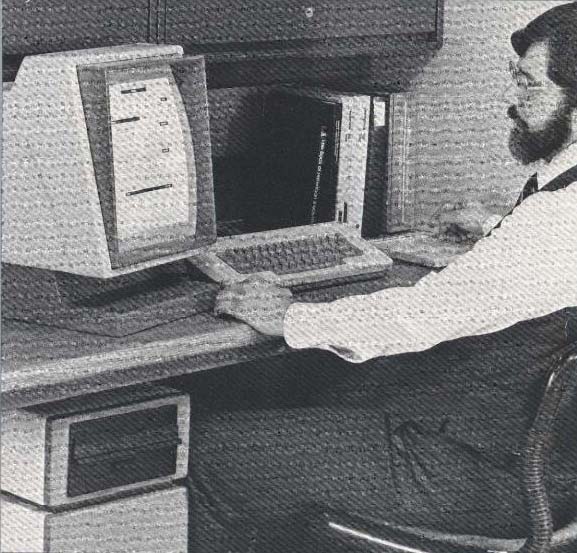
RAL had difficulty getting sufficient copies of the brochure to satisfy demand. In consequence, a local version of the Three Rivers Brochure was produced that substituted a photograph of David Duce, the Coordinator of the Distributed Computing Systems Specially Promoted Programme, sitting in the RAL PERQ Demo Room. The text was not changed.
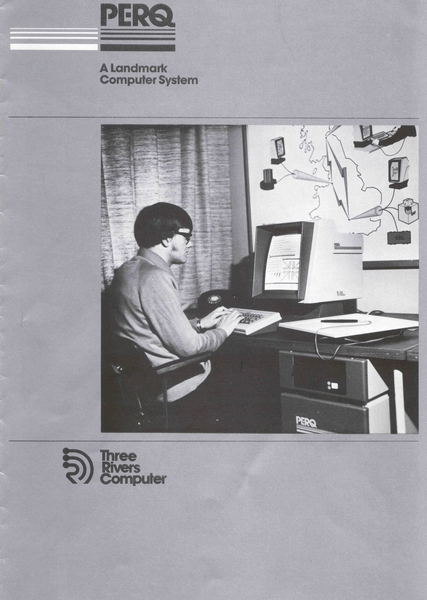
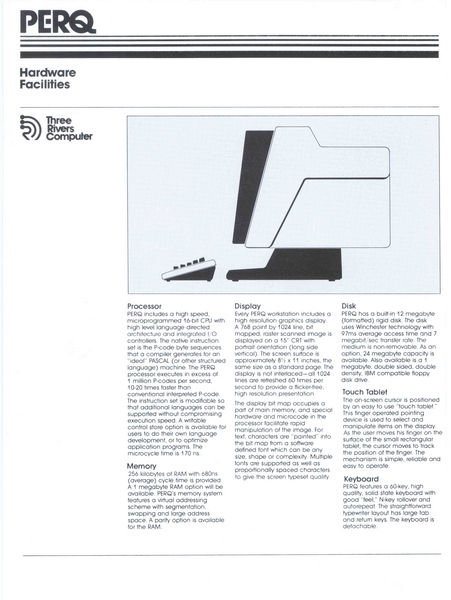
PERQ includes a high speed, microprogrammed 16-bit CPU with high level language directed architecture and integrated I/O controllers. The native instruction set is the P-code byte sequences that a compiler generates for an ideal PASCAL (or other structured language) machine. The PERQ processor executes in excess of 1 million P-codes per second, 10-20 times faster than conventional interpreted P-code. The instruction set is modifiable so that additional languages can be supported without compromising execution speed. A writable control store option is available for users to do their own language development, or to optimize application programs. The microcycle time is 170 ns.
256 kilobytes of RAM with 680ns (average) cycle time is provided. A 1 megabyte RAM option will be available. PERQ's memory system features a virtual addressing scheme with segmentation, swapping and large address space. A parity option is available for the RAM.
Every PERQ workstation includes a high resolution graphics display. A 768 point by 1024 line, bit mapped, raster scanned image is displayed on a 15" CRT with portrait orientation (long side vertical). The screen surface is approximately 8½ x 11 inches, the same size as a standard page. The display is not interlaced - all 1024 lines are refreshed 60 times per second to provide a flicker-free, high resolution presentation.
The display bit map occupies a part of main memory, and special hardware and microcode in the processor facilitate rapid manipulation of the image. For text, characters are painted into the bit map from a software defined font which can be any size, shape or complexity. Multiple fonts are supported as well as proportionally spaced characters to give the screen typeset quality.
PERQ has a built-in 12 megabyte (formatted) rigid disk. The disk uses Winchester technology with 97ms average access time and 7 megabit/see transfer rate. The medium is non-removable. As an option, 24 megabyte capacity is available. Also available is a 1 megabyte, double sided, double density, IBM compatible floppy disk drive.
The on-screen cursor is positioned by an easy to use touch tablet. This finger operated pointing device is used to select and manipulate items on the display. As the user moves his finger on the surface of the small rectangular tablet, the cursor moves to track the position of the finger. The mechanism is simple, reliable and easy to operate.
PERQ features a 60-key, high quality, solid state keyboard with good feel, N-key rollover and autorepeat. The straightforward typewriter layout has large tab and return keys. The keyboard is detachable.
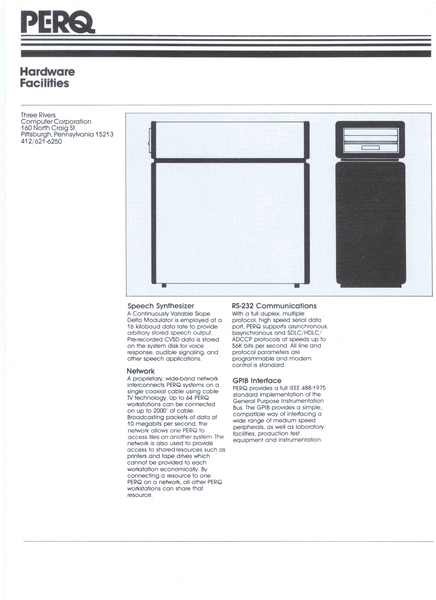
A Continuously Variable Slope Delta Modulator is employed at a 16 kilobaud data rate to provide arbitrary stored speech output. Pre-recorded CVSD data is stored on the system disk for voice response, audible signalling, and other speech applications.
A proprietary, wide-band network interconnects PERQ systems on a single coaxial cable using cable TV technology. Up to 64 PERQ workstations can be connected on up to 2000' of cable. Broadcasting packets of data at 10 megabits per second, the network allows one PERQ to access files on another system. The network is also used to provide access to shared resources such as printers and tape drives which cannot be provided to each workstation economically. By connecting a resource to one PERQ on a network, all other PERQ workstations can share that resource.
With a full duplex, multiple protocol, high speed serial data port, PERQ supports asynchronous, bisynchronous and SDLC/HDLC/ADCCP protocols at speeds up to 56K bits per second. All line and protocol parameters are programmable and modem control is standard.
PERQ provides a full IEEE 488-1975 standard implementation of the General Purpose Instrumentation Bus. The GPIB provides a simple, compatible way of interfacing a wide range of medium speed peripherals, as well as laboratory facilities, production test equipment and instrumentation.
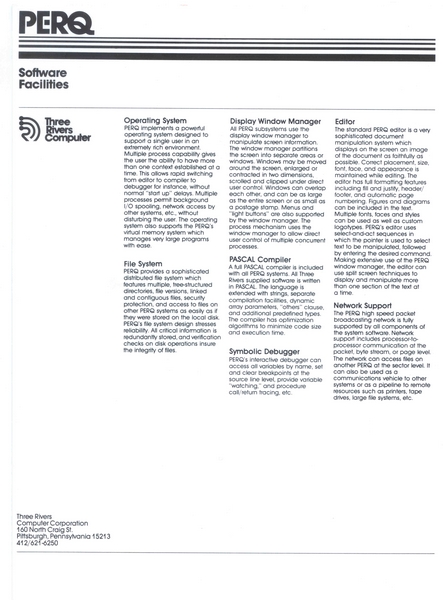
PERQ implements a powerful operating system designed to support a single user in an extremely rich environment. Multiple process capability gives the user the ability to have more than one context established at a time. This allows rapid switching from editor to compiler to debugger for instance, without normal start up delays. Multiple processes permit background I/O spooling, network access by other systems, etc., without disturbing the user. The operating system also supports the PERQ's virtual memory system which manages very large programs with ease.
PERQ provides a sophisticated distributed file system which features multiple, tree-structured directories, file versions, linked and contiguous files, security protection, and access to files on other PERQ systems as easily as if they were stored on the local disk. PERQ's file system design stresses reliability. All critical information is redundantly stored, and verification checks on disk operations insure the integrity of files.
All PERQ subsystems use the display window manager to manipulate screen information. The window manager partitions the screen into separate areas or windows. Windows may be moved around the screen, enlarged or contracted in two dimensions, scrolled and clipped under direct user control. Windows can overlap each other, and can be as large as the entire screen or as small as a postage stamp. Menus and light buttons are also supported by the window manager. The process mechanism uses the window manager to allow direct user control of multiple concurrent processes.
A full PASCAL compiler is included with all PERQ systems. All Three Rivers supplied software is written in PASCAL. The language is extended with strings, separate compilation facilities, dynamic array parameters, others clause, and additional predefined types. The compiler has optimization algorithms to minimize code size and execution time.
PERQ's interactive debugger can access all variables by name, set and clear breakpoints at the source line level, provide variable watching, and procedure call/return tracing, etc.
The standard PERQ editor is a very sophisticated document manipulation system which displays on the screen an image of the document as faithfully as possible. Correct placement, size, font, face, and appearance is maintained while editing. The editor has full formatting features including fill and justify, header/ footer, and automatic page numbering. Figures and diagrams can be included in the text. Multiple fonts, faces and styles can be used as well as custom logotypes. PERQ's editor uses select-and-act sequences in which the pointer is used to select text to be manipulated, followed by entering the desired command. Making extensive use of the PERQ window manager, the editor can use split screen techniques to display and manipulate more than one section of the text at a time.
The PERQ high speed packet broadcasting network is fully supported by all components of the system software. Network support includes processor-to-processor communication at the packet, byte stream, or page level. The network can access files on another PERQ at the sector level. It can also be used as a communications vehicle to other systems or as a pipeline to remote resources such as printers, tape drives, large file systems, etc.
Three Rivers Computer Corporation
160 North Craig St.
Pittsburgh, Pennsylvania 15213
412/621-6250